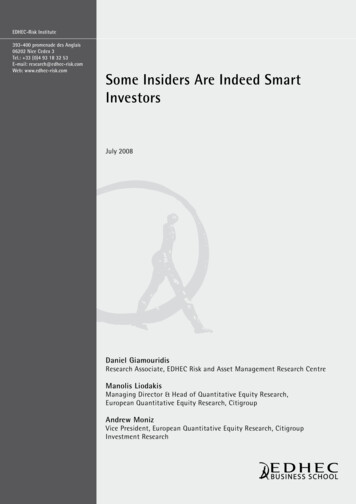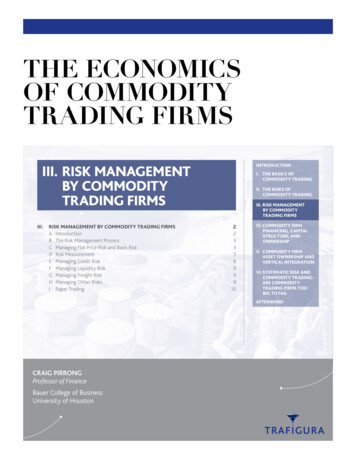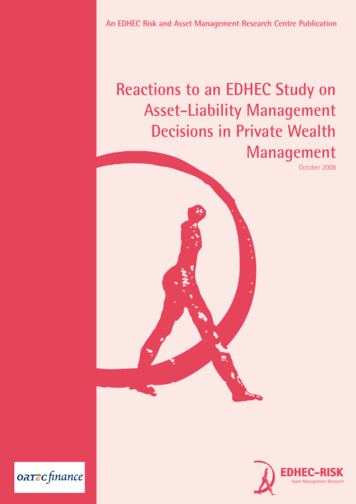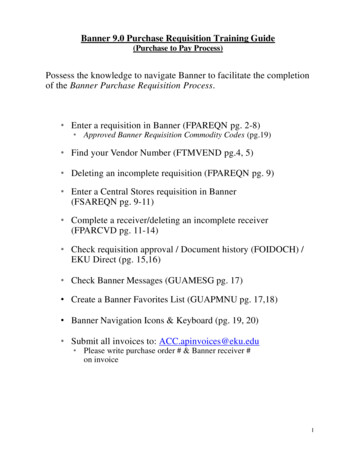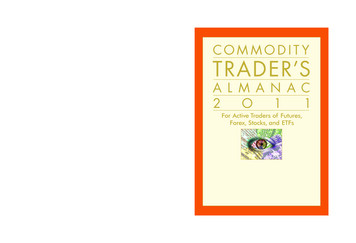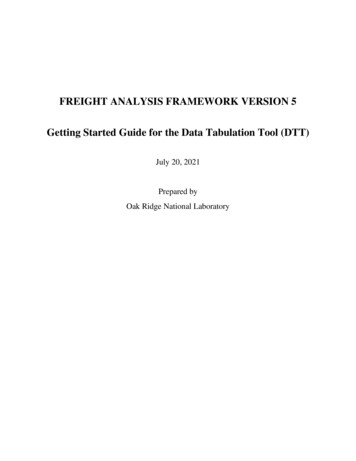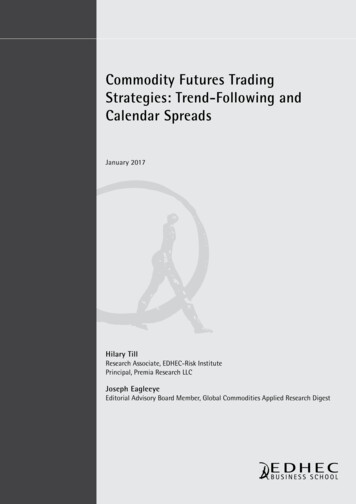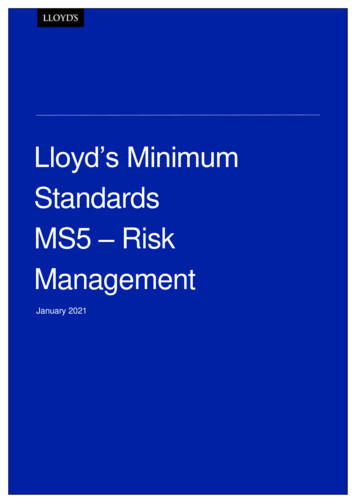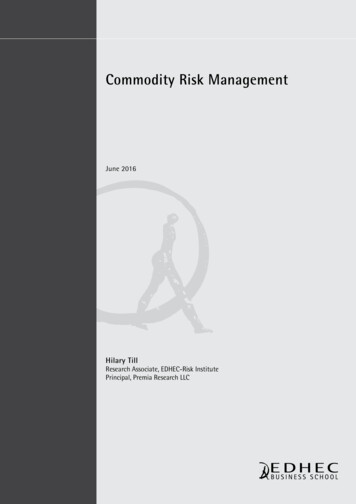
Transcription
Commodity Risk ManagementJune 2016Hilary TillResearch Associate, EDHEC-Risk InstitutePrincipal, Premia Research LLC
AbstractThis article discusses the practical issues involved in applying a disciplined risk managementmethodology to commodity futures trading. Accordingly, the paper shows how to applymethodologies derived from both conventional asset management and hedge fund managementto futures trading. The article also discusses some of the risk management issues that are uniqueto leveraged futures trading.The ideas in this article were jointly developed with Joseph Eagleeye, co-founder of Premia ResearchLLC. In addition, this article is an updated version of Till (2002).EDHEC is one of the top five business schools in France. Its reputation is built on the high quality ofits faculty and the privileged relationship with professionals that the school has cultivated since itsestablishment in 1906. EDHEC Business School has decided to draw on its extensive knowledge of theprofessional environment and has therefore focused its research on themes that satisfy the needs ofprofessionals.2EDHEC pursues an active research policy in the field of finance. EDHEC-Risk Institute carries outnumerous research programmes in the areas of asset allocation and risk management in both thetraditional and alternative investment universes.Copyright 2016 EDHEC
Commodity futures trading is such a niche discipline that discovering how to succeed usingdisciplined risk-management principles usually only occurs through hard-won experience. Thisarticle provides an alternative approach: one can instead study a logical structural framework,as set forth in this article.In covering the topic of commodity risk management, this practitioner-oriented paper proceedsas follows. A number of trading strategies exist because the trader is being paid to bear risk: thatis why they can continue to exist, even if well-known. But then in order for a trading programto be viable in the long-term, a trader must implement disciplined risk management procedures.The key parameters for a risk-management program include quantifying a client’s risk toleranceand attempting to ensure that one does not exceed that tolerance as well as understanding theprice behaviour of commodity futures prices and their potential for explosive behaviour. Both ofthese parameters are essential for the choice of leverage level and hedging strategy for a tradingprogram. Next the paper covers two types of useful risk metrics for a trading program, whichinclude Value-at-Risk and historical worst-case measures. The article then discusses how to avoidinadvertent concentration risk, namely by understanding the fundamental drivers of a strategy.The paper also advocates the use of (a) out-of-the-money options to hedge against identifiableextreme scenarios and (b) disciplined exit strategies for when trading strategies exceed worstcase outcomes. Finally, the paper enumerates what should be included in a trading program’srisk-management reports.Risk is the Flipside of ReturnIn a number of derivatives trading strategies, a trader is paid to bear risks that others wouldprefer to lay off or not take on. What Keynes (1935) wrote is just as true today: “The violenceof the fluctuations which normally affect the prices of many individual commodities showswhat a great risk the short-period speculator in commodities runs, for which he requires to beremunerated on a corresponding scale.”A number of derivatives trading strategies are well known and publicised, which does not preventthem from continuing to exist. For example, trades that have appeared in 1980s commoditybrokerage recommendations and have been published in the Journal of Futures Markets andother empirically oriented journals are still valid in some form today.In discussing consistently profitable grain futures trades, Cootner (1967) stated that the fact thatthey “persist in the face of such knowledge indicates that the risks involved in taking advantageof them outweigh the gain involved. This is further evidence that [commercial participants do]not act on the basis of expected values; that [these participants are] willing to pay premiumsto avoid risk.”In a number of statistically significant futures trades, an individual who implements these tradesassumes some specific event risk that others do not want to assume, which is why there is areturn to efficiently bearing this risk in the first place.The Most Important Element of an Investment processThe key to a successful program is not in discovering proprietary investment strategies: a diligentliterature search will turn up a great number of strategies, as noted above.Instead, the most important element of an investment process may well be how one implementsthe program’s portfolio construction and risk management methodologies so that one can haveboth smooth performance and stay in business during dramatic market moves. This point will befurther elaborated on below.3
Product Design issuesIn derivatives trading, one has a lot of flexibility in designing such a program. Futures tradingrequires a relatively small amount of margin. For example in some futures programs, one onlyneeds to set aside about 7 for each 100 of exposure. The result is that one can easily adjustone’s leverage level to magnify gains (and of course, magnify losses, too.) Trade sizing is mainlya matter of how much risk one wants to assume. A trader is not very constrained by the amountof initial capital committed to trading. With the use of options, one can also be very particularabout the risks that the trader wishes to hedge away by paying option premia.What leverage level is chosen for a program and which risks are hedged are product designissues. One needs to determine: “How will the program be marketed, and what will the client’sexpectations be?” A number of top Commodity Trading Advisors (CTAs) have had losses in excessof –30%, which seem to have been acceptable to their clients since these programs sometimesproduce 100% annual returns. Investors know upfront the sort of swings in profits and lossesto expect from such managers.Further, investors in futures programs frequently expect a long-options-like payoff profile fromsuch trading programs. Exhibit 1 provides an example of a crude oil futures trading strategythat, at least historically, has the desired long-options-like payoff profile (the “conditionallyentered” Brent futures strategy) while passively entering into Brent oil futures contracts does not(the “unconditionally entered” Brent futures strategy).Exhibit 1: “Conditionally Entered” vs. “Unconditionally Entered” Brent Crude Oil Futures (Excess) Returns End-January 1999 through EndDecember 2014[The calculations underlying this chart were performed by Joseph Eagleeye, Premia Research LLC.]Source: Till (2015), Slide 37.CTA investors also frequently expect futures trading programs to be equity diversifiers, so clientsthereby expect that a trading program will not do too poorly in the face of a large equity decline.The parameters of a program’s risk management policy should directly flow from the return, risk,and correlation expectations of the program’s client base. When attempting to adhere to thesetop-level parameters, the actual implementation of a program’s risk management policy will relyheavily on the particular assumptions about the statistical properties of futures prices, as will bediscussed later.4
Viability of a Future ProgrammAs noted earlier, a number of statistically significant trading opportunities exist because ofthe possibility of rare, but nonetheless large, losses. One can build a business or investmentprogram around these positive expected value opportunities, but the particular leverage leveland hedging strategy chosen determines the ongoing viability of the program. For example, thebasic strategies employed by the following institutions were backed by historical experience: The U.S. savings and loan industry’s strategy in the 1980s in exploiting a persistently steep yieldcurve had been historically valid; Metallgesellschaft’s strategy in 1993 in exploiting the persistently backwardated shape ofseveral energy futures contracts had also been historically profitable; Long Term Capital Management’s strategy in 1998 in profiting from convergence trades in thefixed-income markets was statistically appropriate; and Amaranth Advisors LLC’s strategy in 2006 of being positioned for extreme weather events hadhistorically provided a long-options-like payoff profile for investors in its natural gas futuresprogram, as discussed in Till (2008).All the strategies noted above are statistically valid, but, nonetheless, resulted in billions of dollarsof losses. Obviously, the leverage level and hedging strategies chosen by these institutions, inretrospect, were flawed.Standard Risk Management MethodologyThe way that risk management is applied at conventional asset managers is typically as follows: Translate the client’s guidelines into return and risk targets with respect to an index orbenchmark; Determine the active bets away from a program’s benchmark; Make assumptions about the expected returns, volatility, and correlation of the active bets; Construct the client’s portfolio so that the client’s return and risk targets will be achieved ifone’s statistical assumptions are correct; and Continually monitor the portfolio’s actual return and risk performance for adherence to theestablished targets.Litterman (1996) noted that “[t]he art of successful portfolio management is not only to beable to identify opportunities, but also to balance them against the risks that they create in thecontext of the overall portfolio.” Risk management is therefore designed into the investmentprocess. The conventional asset manager approach to risk management is a useful first step indesigning a risk management program for leveraged futures trading. As will be discussed, onestill needs to add several layers of risk management to this approach because of the uniquestatistical properties of commodity futures contracts and because of the different way futuresproducts are marketed.A futures product typically does not have a benchmark so the conventional asset managerapproach of translating a client’s guidelines into risk and return targets with respect to an indexdoes not directly apply. Instead, one needs to determine what the acceptable total-return-tototal-risk trade-off is for a client. Given the ability to leverage, a number of CTA’s offer 1-time,2-time, and 3-time versions of the same program. In other words, a client can directly choose theleverage level for their investment based on their ability to tolerate losses of a given magnitude.The second step in a conventional asset manager approach to risk management consists of makingassumptions about expected returns, risks, and correlations of active bets. It is at this point thatthe unique behaviour of commodity prices creates extra steps in a risk management program.5
Understanding Price BehaviourResearch from the 1970s showed that diversified portfolios of equities have returns that appearto be symmetrically distributed. It is a different matter for commodity prices.Deaton and Laroque (1992) noted the following about the empirical behavior of the prices of anumber of commodities: “Commodity prices are extremely volatile”; There exist “rare but violent explosions in prices”; In normal times, there is a “high degree of price autocorrelation”; “In spite of volatility, prices tend to revert to their mean or to a trend” level; “There is substantial positive skewness” in the price distributions; and There is “substantial kurtosis with tails much thicker than those of the normal distribution.”Commodity prices tend to exhibit positive skewness for the following reason. During times ofample supplies, there are two variables that can adjust to equilibrate supply and demand: moreinventories can be held and the price can decrease. But, if there are inadequate inventories, onlythe price can respond to equilibrate supply and demand, given that in the short run, new suppliesof physical commodities cannot be instantly mined, grown, and/or drilled.Value-at-RiskIf a portfolio of instruments is normally distributed, one can come up with the 95% confidenceinterval for the portfolio’s change in monthly value by multiplying the portfolio’s recent monthlyvolatility by two (or 1.96, to be exact.) The portfolio’s volatility is calculated from the recentvolatilities and correlations of the portfolio’s instruments. This is the standard Value-at-Riskapproach. Now, this approach alone is obviously inadequate for a commodity portfolio, whichconsists of instruments that have a tendency towards extreme positive skewness.While this measure is useful, it has to be used jointly with other measures and actions. Themeasure is useful since one wants to ensure that under normal conditions, a commodity positionhas not been sized too large that one cannot sustain the random fluctuations in profits and lossesthat would be expected to occur, even without a dramatic event occurring. Sizing a trade basedon its volatility is especially important the longer the frequency of predictability is. For example,if a trade’s predictability is at quarterly intervals, the trade has to be sized to withstand the dailyfluctuations in profits and losses.In one extreme example, Lettau and Ludvigson (2001) have found that equities are predictable atbusiness cycle frequencies. But that means that one cannot have a leveraged investment processto take advantage of this predictability.Scenario TestingUsing long-term data, a trader should directly examine the worst performance of a commoditystrategy under similar circumstances in the past. In practice, such a measure will sometimes belarger than a Value-at-Risk measure based on recent volatility.One should examine the worst performance of a futures trade over the entire time horizon ofthe trade rather than looking at what its worst performance was over a period of say, three days.Markets are “learning systems.” During a price shock, if a similar event occurred in the past,market participants know what the magnitude of the price move was during the past event. Soan entire, dramatic price move may occur in a shortened timeframe compared to the past.6In practice, if a market only has limited historical data, it would be prudent to scale down the sizeof a position in such a market since one may not be able to get a complete idea of the range ofpossible outcomes.
If one is relying on historical data to find pockets of predictability in the futures markets, thenexamining worst-case outcomes can also serve another purpose. If the loss on a particularcommodity futures strategy exceeds the historical worst case, this can be an indication of a newregime that is not reflected in the data. This would trigger an exit from a systematic trade sinceone no longer has a handle on the worst-case scenario.An example of a fundamental structural change occurring in a commodity market was provided byFusaro (2005). He reveals that in the summer of 2005, “the big Wall Street houses and some otherhedge funds lost many hundreds of millions [of dollars] on gasoline/heating oil spreads. Theycould not imagine that heating oil would go higher than gasoline in June. It just never happenedbefore.”The conclusion from this discussion is that a commodity program will not experience the full bruntof a structural break if one exits a trading strategy after experiencing losses that are greater thanhave been the case in the past, as noted in Till (2006).Deep Out-of-the-Money OptionsIn a systematic program based on historical data, one can make determinations about its expectedreturn. One result is that a trader can decide to give up a small fraction of this expected return inorder to hedge against catastrophic risk. A trader can do so with deep out-of-the-money options.This choice is especially advisable for commodity futures positions that require physical deliveryat maturity. This means that contracts can be periodically squeezed to quite unpredictably highlevels.Exit StrategyAlthough strictly speaking not a risk management issue, one should employ an exit strategy thatrecognises the mean-reverting properties of commodities. This means examining historical datato determine the typical size of moves during supply/demand imbalances.Diversification and Concentration RiskAs discussed in Till (2001), a commodity manager can potentially set up dampened risk portfoliosof commodity trades, which are very nearly uncorrelated with each other. For example, Exhibit2 shows the annualised portfolio volatility versus the number of commodity strategies for aportfolio from June of 2000. Based on three months of price data, these strategies had correlationsamongst each other of between –20% and 20%. The exhibit demonstrates the beneficial effectof incrementally adding unrelated trades on portfolio volatility.Exhibit 2: Portfolio Volatility vs. Number of strategiesSource: Till (2000), Exhibit 5.Copyright Institutional Investor, Inc.7
Now for all types of leveraged trading, a key risk management concern is inadvertent concentrationrisk. So for example, equity option market-makers will try to ensure that their book of trades doesnot have inadvertent style and industry concentrations.In leveraged commodity futures trading, one must be careful with commodity correlationproperties. Humphreys and Shimko (1997) discuss how correlations amongst commodity marketscan be highly seasonal. Their specific example discusses the correlation of natural gas in differentregions, which depends on whether it is summer or winter.In addition, seemingly unrelated commodity markets can become temporarily highly correlated.This becomes a problem if commodity managers are designing their portfolios so that only acertain amount of risk is allocated per strategy. The portfolio manager may be inadvertentlydoubling up on risk if two strategies are unexpectedly correlated.Understanding the Fundamental Drivers of a StrategyThe antidote for this problem is two-fold. One is to understand what the key factors are whichdrive a strategy’s performance, and the other is to use short-term recent data in calculatingcorrelations. If two trades have common drivers, then it can be assumed that their respectiveperformances will be similar. Recent data can frequently capture the time-varying nature ofcorrelations that long-term data average out.Corn and Natural Gas ExampleThe following graphs in Exhibits 3 and 4 provide an example from 2011 that show how seeminglyunrelated markets can become temporarily very related.Exhibit 3: Front-Month Corn Futures Prices versus Front-Month Natural Gas Futures PricesSource of Data: The Bloomberg.Exhibit 4: Front-Month Corn Futures Prices versus Front-Month Natural Gas Futures PricesSource of Data: The Bloomberg.8
Normally, natural gas and corn prices are unrelated. But during the summer, they can becomehighly correlated, as shown in Exhibit 4. Depending on the values of key fundamental drivers,two prospective trades in the summer are to be short these two commodities. Now, the empiricalevidence seems to show that these two trades may be the same trade. So, if one puts both ofthese trades in their portfolio, one would be inadvertently doubling up on risk. How could thesetwo seemingly different trades be, in fact, the same trade?To answer this question, one needs to understand why these two trades tend to work. These twotrades are part of a class of trades called, “Weather Fear Premium” trades. In this class of trades,as explained in Di Tomasso and Till (2000): “A futures price will sometimes embed a fear premiumdue to upcoming, meaningful weather events. One cannot predict the weather, but one canpredict how people will systematically respond to upcoming weather uncertainty. In this classof trades, a futures price is systematically too high, reflecting the uncertainty of an upcomingweather event. We say the price is too high when an analysis of historical data shows that onecan make statistically significant profits from being short the commodity futures contract duringthe relevant time period. And further that the systematic profits from the strategy are sufficientlyhigh that they compensate for the infrequent large losses that occur when the feared, extremeweather event does in fact occur.”Till (2000) gave several examples of this strategy, including ones from the corn and natural gasmarkets, as discussed below.Corn“Its key pollination period is about the middle of July. If there is adverse weather during this time,new-crop corn yields will be adversely affected. This means that the new-crop supply would besubstantially lessened, dramatically increasing prices. A systematic trade is to short corn futuresfrom June through July. There is systematically too high a premium embedded in corn futurescontracts during the pre-pollination time period.”Natural Gas“In July, there is fear of adverse hot weather in the US Northeast and Midwest. Air conditioningdemand can skyrocket then. From June to mid-July, a systematic trade is to short natural gasfutures contracts at the height of a potential weather scare.”Both the July corn and natural gas trades are therefore heavily dependent on the outcome ofweather in the U.S. Midwest. Exhibit 5 further illustrates how both corn and natural gas hadcommon reactions to the possibility of extreme heat in 2011: their prices frequently waxed andwaned at similar times during the summer, as would be expected from the discussion above.Exhibit 5: Front-Month Corn Futures Prices and Front-Month Natural Gas Futures Prices (6/1/11 to 7/15/11)Source of Data: The Bloomberg.9
Our conclusion is that in order to avoid inadvertent correlations, it is not enough to measurehistorical correlations. Instead, a trader needs to have an economic understanding for why a tradeworks in order to best be able to appreciate whether an additional trade will act as a portfoliodiversifier.Extraordinary Stress TestingAs discussed above, risk management policies flow from product design decisions. Futures productsare typically marketed as equity investment diversifiers. Therefore, one job of risk managementis to attempt to ensure that a futures program will not be correlated to the equity market duringperiods of dramatic equity losses. This is not an issue for say, an equity mutual fund. During atime of stress in the equity markets, clients would expect that their equity fund would performpoorly.This extra risk management step is unique to alternative investments, again, because of theway they are marketed. For example, funds of hedge funds have also been marketed as equitydiversifiers, so this has also a particular area of concern for such funds. Since fund-of-funds havetypically included a lot of arbitrage strategies, which in turn rely on the ability to leverage, fundof-funds have been at risk to liquidity shocks. And the equity markets typically also do poorlyduring liquidity shocks.One potential solution has been to include an interest-rate overlay in such funds. The interestrate overlay consists of going long Eurodollar (short-term U.S. interest rate) futures, which do wellwhen short-term interest rates are cut. The Federal Reserve Board’s (Fed’s) response to liquidityshocks has typically been to loosen monetary policy so a Eurodollar overlay could plausibly offsetlosses in portfolios consisting of arbitrage strategies.This type of macro hedging is very applicable to commodity futures programs as well. A number ofcommodity futures strategies have a long commodity bias since they rely on taking on inventoryrisk that commercial participants wish to lay off. One consequence is that these strategies are atrisk to sharp shocks to business confidence. And during sharp shocks to business confidence asoccurred in the aftermath of September 11th 2001, the stock market performs quite poorly.Obviously one would prefer to layer on natural hedges, which themselves have positive expectedvalue. This is sometimes possible in a diversified futures program. For example, in the fall theretends to be a number of statistically significant commodity trades that have a long bias. Also,at the same time there are a number of statistically significant long fixed income trades. Bycarefully combining these trades, the fixed-income trades operate as a natural hedge to the eventrisk taken on with the long commodity trades. (This is as it should be based on Miron (1996)’shistorical review and analysis. The author describes how the Federal Reserve System was set up in1914 in part as a response to reoccurring financial panics that had occurred in the 19th Centurydue to predictable seasonal liquidity drains, necessitating the creation of an “elastic currency.”)The hedge fund world also provides other risk management solutions that are applicable to futuresprograms. One concern for a fund-of-funds is that its group of funds is inadvertently exposedto some event risk like an emerging markets shock. This issue is compounded by the fact that ahedge fund investor is frequently not allowed to see what a hedge fund is investing in becausethis is considered proprietary information by a hedge fund.One risk management software provider solved this problem by confidentially collecting hedgefund portfolios and directly determining their sensitivity to past financial shocks. For example,if one held a particular fund-of-funds portfolio during October 1987, one could see how that10
portfolio would have performed during the stock market crash. This scenario test gives anindication of sensitivity to a stock market crash.For a commodity futures portfolio, it is prudent to examine how the portfolio would have performedduring various well-defined stock market declines, given that such programs are marketed asequity portfolio diversifiers. Also, various crises have shown that the only thing that goes upduring such times is correlation! If a portfolio shows sensitivity to certain extreme events whenthe stock market has declined, this does not necessarily mean that the portfolio should be sizeddifferently or constructed differently. It may mean that a macro portfolio hedge would be inorder such as purchasing out-of-the-money Eurodollar call options, as noted above.Risk Management ReportsOn a per-strategy basis, it is useful to examine each strategy’s: Value-at-Risk based on recent volatilities and correlations; Worst-case loss during normal times; Worst-case loss during well-defined eventful periods; Incremental contribution to Portfolio Value-at-Risk; and Incremental contribution to Worst-Case Portfolio Event Risk.The latter two measures give an indication if the strategy is a risk reducer or risk enhancer.On a portfolio-wide basis, it is useful to examine the portfolio’s: Value-at-Risk based on recent volatilities and correlations; Worst-case loss during normal times; and Worst-case loss during well-defined eventful periods.Each measure should be compared to some limit, which has been determined based on the designof the futures product. So for example, if clients expect the program to lose no more than say7% from peak-to-trough, then the three portfolio measures should be constrained to not exceed7%. If the product should not perform too poorly during financial shocks, then the worst-caseloss during well-defined eventful periods should be constrained to a relatively small number. Ifthat worst-case loss exceeds the limit, then one can devise macro portfolio hedges accordingly.Now obviously the danger with these recommended approaches is that one is relying on historicaldata for guidance since completely unprecedented events do happen. That is why one shouldexit any futures trades in which the losses exceed those known in history since one is then inuncharted territory.ConclusionThere are a number of derivatives strategies, that earn returns due to assuming risk positionsin a risk-adverse financial world. The returns are not necessarily due to inefficiencies in themarketplace.There is a very important active component to a futures program that earns a return due tobearing risk. It is the trading program’s risk management methodology and policy. A managermust decide how much to leverage the strategy and whether to give up any returns by hedgingout some strategy’s extreme risks. That manager must also continually monitor the risk exposuresin his or her portfolio and make sure that those exposures adhere to pre-defined limits.11
In designing a risk management framework, a leveraged futures trader can use as a starting pointthe framework provided by conventional asset managers and also by fund of hedge fund managers.We conclude by noting that how traders design and carry out their risk management policies is keyto their futures program’s viability, especially in leveraged commodity futures trading.References Cootner, Paul, 1967, “Speculation and Hedging,” Food Research Institute Studies, Supplement,pp. 65-106. DiTomasso, John, and Hilary Till, 2000, “Active Commodity-Based Investing,” Journal of AlternativeInvestments, Summer, pp. 70-80, Deaton, Angus, and Guy Laroque, 1992, “On the Behavior of Commodity Prices,” Review ofEconomic Studies, January, pp. 1-23. Fusaro, Peter, 2005, “Energy: An Immature Financial Market,” Energy Hedge, October, p.1. Humphreys, Brett and David Shimko, 1997, “Commodity Risk Management and the CorporateTreasury,” in Financial Risk and the Corporate Treasury, (London: Risk Publications), p. 115. Keynes, John Maynard, 1935, A Treatise on Money: The Applied Theory of Money, Vol. II, (London:Macmillan and Company Limited), pp. 136-9. Lettau, Martin and Sydney Ludvigson, 2001, “Consumption, Aggregate Wealth, and ExpectedStock Returns,” Journal of Finance, June, pp. 815-849. Litterman, Robert, 1996, “Hot
disciplined risk-management principles usually only occurs through hard-won experience. This article provides an alternative approach: one can instead study a logical structural framework, as set forth in this article. In covering the topic of commodity risk management, this practitioner-oriented paper proceeds as follows.
